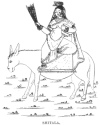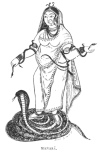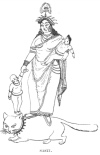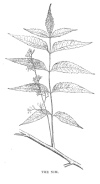
Sacred Texts Hinduism Index Previous Next


Hindu Mythology, Vedic and Puranic, by W.J. Wilkins, [1900], at sacred-texts.com
Shitala is the Bengali name for the small-pox, and for the deity who is supposed to have charge of that disease. The meaning of the word is "She who makes cold."

Click to enlarge
SHITALA.
This goddess is represented as a golden-complexioned woman sitting on a lotus, or riding on an ass, dressed in red clothes. Before an image of this kind, or more
commonly a pan of water merely, Shitala is worshipped in the hope that she will preserve her worshippers from this dire disease.
In the spring of the year, the Hindus formerly inoculated their children for this disease when they were about two years of age. The Brāhman who performed the operation made presents to render Shitala propitious, and promised, in case the work was successful, to give still greater gifts. At the close of the operation the flowers that were presented to the goddess were placed in the hair of the child as a charm. On behalf of those afflicted with small-pox, offerings are made daily; and when the patient is thought to be dangerously ill, he is placed in front of an image of Shitala, bathed in, and given to drink, water that has been offered to her. Beggars go about with a stone, partly gilded, which they teach is sacred to Shitala, and, in seasons when the disease is prevalent, receive presents from the superstitious. *
Manasā is the sister of Vasuki, king of the snakes; the wife of Jaratkāru, a sage; and being the queen of the snakes is regarded as the protectress of men from those reptiles. Another name by which she is known is Vishahara, "the destroyer of poison." Generally, offerings are made to her without any image being made, a branch of a tree, a pan of water, an earthen snake being her representative; when her image is made, it is that of a woman clothed with snakes, sitting on a lotus, or standing upon a snake. A song founded upon the following story concludes the worship of this deity.
A merchant named Chānda not only refused to worship Manasā, but professed the profoundest contempt for her. In process of time six of his sons died from snake-bites. To avoid a similar fate, his eldest son Lakindara dwelt in an iron house; but Manasā caused a snake to enter through a crevice, which bit him on his wedding-day and caused his death too. His widow, however, escaped, and went weeping to her mother-in-law,

Click to enlarge
MANASĀ.
who, with the neighbours, vainly tried to induce Chānda to propitiate the goddess through whose influence so much evil had come to the family; Manasā herself urged his friends to prevail upon him not to remain so hostile to her. At last he so far yielded to
their wishes as to throw a single flower with his left hand towards her image, which so delighted her that she restored his sons to life, and from that time, as men came to know of her power, her worship has become celebrated. *
The Mahābhārata gives the following particulars regarding her marriage. Jagatakāru, her husband, was an eminent sage, who had practised great austerities, bathed in all the holy tanks, abstained from matrimony, and, as a result of his penance and fasting, had a dry and shrivelled body. In the course of his wanderings, he came to a place where he saw a number of men hanging from a tree with their heads downwards over a deep abyss, with a rat gnawing the rope by which they were suspended, and learned that they were his own ancestors, doomed to endure this misery because, their children being dead, they had no one to release them (i.e. by performing religious ceremonies); and he, who, by having a son might have set them free, was given up to a life of austerity, and refused to marry. When they are told that Jagatakāru is the man through whose abstinence they are suffering, they entreat him to seek a wife and secure their deliverance. He consents to do so on condition that the parents of the girl he marries give her to him willingly. Vāsuki hearing of this, offers his sister to the sage, who marries her and has a son named Asika. This son effected the deliverance of his ancestors and also rendered good service to the serpent race in saving them from destruction when Janamejaya was wishful to exterminate them.
Sastī is peculiarly the goddess of married women; she is the giver of children, assists at childbirth, and is the guardian of young children. She is represented as a golden-complexioned woman with a child in her arms, riding upon a cat; hence no Hindu woman would under

Click to enlarge
SASTI.
any circumstances injure that animal, lest she should offend the goddess and be made to suffer for it. Six times a year festivals in honour of Sastī are held; in addition to which, women who have lost their children by death worship her monthly. When a child is six days old, the father worships her; and when three
weeks old, the mother presents offerings to her. The ordinary representative of Sastī is a stone about the size of a man's head, placed under a Banyan tree, which is decorated with flowers, and offerings of rice, fruit, etc., are made to it. *
By the worshippers of Vishnu, the Shālgrāma is regarded as a most sacred object. It does not derive its sacredness from consecrating rites, as images and other representatives of deities, but is believed to be inherently holy. It is a black ammonite, found in Mount Gandakī in Nepal. The popular belief is that in this mountain there are insects which perforate the stones; and when perforated, falling into the river Gandaka, they are taken out by means of nets. The more common ones are about the size of a watch, and their price varies according to their size, hollowness, and inside colouring, according to which peculiarities special names are given. For the rarer kinds as much as Rs. 2000 are given; and as it is the common belief of the people that the possessor of one of these, and a shell called Dakshināvarta (i.e. a shell whose convolutions are towards the right), can never be poor, it is not to be wondered at that large prices should be paid for them. As it is also believed that in parting with them they invite misfortune, it is natural that few should wish to part with them; to sell them for gain is regarded as a most dishonourable deed.
A reason for the sacredness of the Shālgrāma is found in the "Bhāgavata Purāna." Sani commenced his reign with a request to Brahmā to become subject to him;
[paragraph continues] Brahmā referred him to Vishnu, who asked him to call upon him the next day. When he called, finding that Vishnu had transformed himself into a mountain, he became a worm named Vajrakīta, and afflicted him for twelve years. At the expiration of that time Vishnu resumed his proper shape, and ordered that henceforth the stones of this mountain (Gandakī) should be worshipped as representatives of himself. *
The Brāhmans usually worship Vishnu in this form in their daily puja at home. In the hot season a vessel is suspended over it, and the water continually dropping on it keeps it cool; another vessel is placed under it to catch the water, which is drunk in the evening by the worshipper. The marks of it are shown to men when dying, in the belief that the concentration of the mind on them at this time will ensure the soul a safe passage to Vishnu's heaven. †
The Dhenkī is a log of wood fixed to a pivot, used for husking rice, pounding bricks for mortar, etc. It is generally worked by women, who, by standing on the one end, raise it to a certain height and then let it fall by its own weight. It is said to be the Vāhan or vehicle of Nārada, and it is believed that, owing to his blessing, it became an object of worship. A religious teacher, when initiating a disciple into the mysteries of Hinduism, told him to say, "Dhenkī, Dhenkī." Nārada, hearing this, was delighted, and coming upon his Vāhan gave him another incantation by which he became
perfect and was admitted into heaven. It is worshipped at the time of marriage, at the investiture of a son with the Poita or Brāhmanical thread, at the ceremony of giving rice to a child, and on other festive occasions. At the close of the last century a Rāja of Naladanga is said to have spent Rs. 300,000 in celebrating the worship of the Dhenkī.
The Athenians were not alone in worshipping the "Unknown God." "The authors of the Brāhmanas had so completely broken with the past, that, forgetful of the poetical character of the hymns (of the Vedas), and the yearning of the poets after the unknown god, they exalted the interrogative pronoun itself into a deity, and acknowledged a god, Ka? or 'Who?' In the 'Taittiriya Brāhmana,' in the 'Kanshītaki Brāhmana,' in the 'Tāndya Brāhmana,' and in the 'Satapatha Brāhmana,' wherever interrogative verses occur, the author states that Ka is Prajāpati, or the lord of creatures. Nor did they stop here. Some of the hymns in which the interrogative pronoun occurred were called Kadvat, i.e., having kad or quid. But soon a new adjective was formed, and not only the hymns, but the sacrifices also, offered to the god, were called Kāya, or 'Who-ish.' At the time of Pānini (the great grammarian), this word had acquired such legitimacy as to call for a separate rule explaining its formation. The commentator here explains Ka by Brāhman. After this, we can hardly wonder that in the later Sanskrit literature of the Purānas, Ka appears as a recognized god, with a genealogy of his own, perhaps even a wife; and that in the laws of Manu one of the recognized forms of marriage, genet ally known by the name of the Prajāpati
marriage, occurs under the monstrous title of Kāya." * In the Mahābhārata Ka is identified with Daksha, and in the "Bhāgavata Purāna" it is applied to Kasyapa, probably on account of their similarity to Prajāpati.

Click to enlarge
THE NIM.
474:* Ward, ii. 139.
476:* Ward, ii. 142.
478:* Ward, ii. 143.
479:* For another account of the origin of the worship of the Shālgrāma, see the account of Tulsi, chap. ix.
479:† Ward, ii. 221.
481:* Max-Müller, quoted in Dowson's Classical Dictionary, s.v. "Ka?"